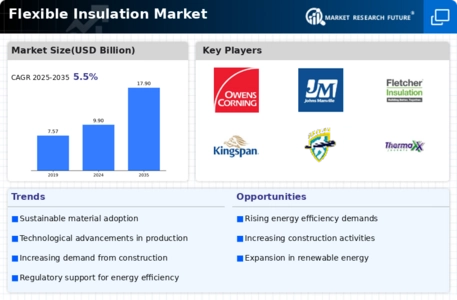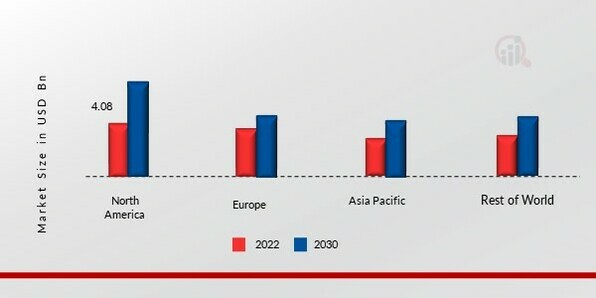. Related Reports LIST OF TABLES TABLE 1 GLOBAL FLEXIBLE INSULATION MARKET, SYNOPSIS, 2025 - 2034 TABLE 2 GLOBAL FLEXIBLE INSULATION MARKET, ESTIMATES & FORECAST, 2025 - 2034 (USD BILLION) TABLE 3 GLOBAL FLEXIBLE INSULATION MARKET, BY TYPE, 2025 - 2034 (USD BILLION) TABLE 4 GLOBAL FLEXIBLE INSULATION MARKET, BY MATERIAL, 2025 - 2034 (USD BILLION) TABLE 5 NORTH AMERICA: FLEXIBLE INSULATION MARKET, BY TYPE, 2025 - 2034 (USD BILLION) TABLE 6 NORTH AMERICA: FLEXIBLE INSULATION MARKET, BY MATERIAL, 2025 - 2034 (USD BILLION) TABLE 7 US: FLEXIBLE INSULATION MARKET, BY TYPE, 2025 - 2034 (USD BILLION) TABLE 8 US: FLEXIBLE INSULATION MARKET, BY MATERIAL, 2025 - 2034 (USD BILLION) TABLE 9 CANADA: FLEXIBLE INSULATION MARKET, BY TYPE, 2025 - 2034 (USD BILLION) TABLE 10 CANADA: FLEXIBLE INSULATION MARKET, BY MATERIAL, 2025 - 2034 (USD BILLION) TABLE 1 EUROPE: FLEXIBLE INSULATION MARKET, BY TYPE, 2025 - 2034 (USD BILLION) TABLE 2 EUROPE: FLEXIBLE INSULATION MARKET, BY MATERIAL, 2025 - 2034 (USD BILLION) TABLE 3 GERMANY: FLEXIBLE INSULATION MARKET, BY TYPE, 2025 - 2034 (USD BILLION) TABLE 4 GERMANY: FLEXIBLE INSULATION MARKET, BY MATERIAL, 2025 - 2034 (USD BILLION) TABLE 5 FRANCE: FLEXIBLE INSULATION MARKET, BY TYPE, 2025 - 2034 (USD BILLION) TABLE 6 FRANCE: FLEXIBLE INSULATION MARKET, BY MATERIAL, 2025 - 2034 (USD BILLION) TABLE 7 ITALY: FLEXIBLE INSULATION MARKET, BY TYPE, 2025 - 2034 (USD BILLION) TABLE 8 ITALY: FLEXIBLE INSULATION MARKET, BY MATERIAL, 2025 - 2034 (USD BILLION) TABLE 9 SPAIN: FLEXIBLE INSULATION MARKET, BY TYPE, 2025 - 2034 (USD BILLION) TABLE 10 SPAIN: FLEXIBLE INSULATION MARKET, BY MATERIAL, 2025 - 2034 (USD BILLION) TABLE 11 UK: FLEXIBLE INSULATION MARKET, BY TYPE, 2025 - 2034 (USD BILLION) TABLE 12 UK: FLEXIBLE INSULATION MARKET, BY MATERIAL, 2025 - 2034 (USD BILLION) TABLE 13 REST OF EUROPE: FLEXIBLE INSULATION MARKET, BY TYPE, 2025 - 2034 (USD BILLION) TABLE 14 REST OF EUROPE: FLEXIBLE INSULATION MARKET, BY MATERIAL, 2025 - 2034 (USD BILLION) TABLE 15 ASIA-PACIFIC: FLEXIBLE INSULATION MARKET, BY TYPE, 2025 - 2034 (USD BILLION) TABLE 16 ASIA-PACIFIC: FLEXIBLE INSULATION MARKET, BY MATERIAL, 2025 - 2034 (USD BILLION) TABLE 17 JAPAN: FLEXIBLE INSULATION MARKET, BY TYPE, 2025 - 2034 (USD BILLION) TABLE 18 JAPAN: FLEXIBLE INSULATION MARKET, BY MATERIAL, 2025 - 2034 (USD BILLION) TABLE 19 CHINA: FLEXIBLE INSULATION MARKET, BY TYPE, 2025 - 2034 (USD BILLION) TABLE 20 CHINA: FLEXIBLE INSULATION MARKET, BY MATERIAL, 2025 - 2034 (USD BILLION) TABLE 21 INDIA: FLEXIBLE INSULATION MARKET, BY TYPE, 2025 - 2034 (USD BILLION) TABLE 22 INDIA: FLEXIBLE INSULATION MARKET, BY MATERIAL, 2025 - 2034 (USD BILLION) TABLE 23 AUSTRALIA: FLEXIBLE INSULATION MARKET, BY TYPE, 2025 - 2034 (USD BILLION) TABLE 24 AUSTRALIA: FLEXIBLE INSULATION MARKET, BY MATERIAL, 2025 - 2034 (USD BILLION) TABLE 25 SOUTH KOREA: FLEXIBLE INSULATION MARKET, BY TYPE, 2025 - 2034 (USD BILLION) TABLE 26 SOUTH KOREA: FLEXIBLE INSULATION MARKET, BY MATERIAL, 2025 - 2034 (USD BILLION) TABLE 27 REST OF ASIA-PACIFIC: FLEXIBLE INSULATION MARKET, BY TYPE, 2025 - 2034 (USD BILLION) TABLE 28 REST OF ASIA-PACIFIC: FLEXIBLE INSULATION MARKET, BY MATERIAL, 2025 - 2034 (USD BILLION) TABLE 29 REST OF THE WORLD: FLEXIBLE INSULATION MARKET, BY TYPE, 2025 - 2034 (USD BILLION) TABLE 30 REST OF THE WORLD: FLEXIBLE INSULATION MARKET, BY MATERIAL, 2025 - 2034 (USD BILLION) TABLE 31 MIDDLE EAST: FLEXIBLE INSULATION MARKET, BY TYPE, 2025 - 2034 (USD BILLION) TABLE 32 MIDDLE EAST: FLEXIBLE INSULATION MARKET, BY MATERIAL, 2025 - 2034 (USD BILLION) TABLE 33 AFRICA: FLEXIBLE INSULATION MARKET, BY TYPE, 2025 - 2034 (USD BILLION) TABLE 34 AFRICA: FLEXIBLE INSULATION MARKET, BY MATERIAL, 2025 - 2034 (USD BILLION) TABLE 35 LATIN AMERICA: FLEXIBLE INSULATION MARKET, BY TYPE, 2025 - 2034 (USD BILLION) TABLE 36 LATIN AMERICA: FLEXIBLE INSULATION MARKET, BY MATERIAL, 2025 - 2034 (USD BILLION) LIST OF FIGURES FIGURE 1 RESEARCH PROCESS FIGURE 2 MARKET STRUCTURE FOR THE GLOBAL FLEXIBLE INSULATION MARKET FIGURE 3 MARKET DYNAMICS FOR THE GLOBAL FLEXIBLE INSULATION MARKET FIGURE 4 GLOBAL FLEXIBLE INSULATION MARKET, SHARE (%), BY TYPE, 2022 FIGURE 5 GLOBAL FLEXIBLE INSULATION MARKET, SHARE (%), BY MATERIAL, 2022 FIGURE 6 GLOBAL FLEXIBLE INSULATION MARKET, SHARE (%), BY REGION, 2022 FIGURE 7 NORTH AMERICA: FLEXIBLE INSULATION MARKET, SHARE (%), BY REGION, 2022 FIGURE 8 EUROPE: FLEXIBLE INSULATION MARKET, SHARE (%), BY REGION, 2022 FIGURE 9 ASIA-PACIFIC: FLEXIBLE INSULATION MARKET, SHARE (%), BY REGION, 2022 FIGURE 10 REST OF THE WORLD: FLEXIBLE INSULATION MARKET, SHARE (%), BY REGION, 2022 FIGURE 11 GLOBAL FLEXIBLE INSULATION MARKET: COMPANY SHARE ANALYSIS, 2022 (%) FIGURE 12 ARMACELL: FINANCIAL OVERVIEW SNAPSHOT FIGURE 13 ARMACELL: SWOT ANALYSIS FIGURE 14 BASF SE: FINANCIAL OVERVIEW SNAPSHOT FIGURE 15 BASF SE: SWOT ANALYSIS FIGURE 16 CONTITECH AG: FINANCIAL OVERVIEW SNAPSHOT FIGURE 17 CONTITECH AG: SWOT ANALYSIS FIGURE 18 FLETCHER INSULATION: FINANCIAL OVERVIEW SNAPSHOT FIGURE 19 FLETCHER INSULATION: SWOT ANALYSIS FIGURE 20 JOHNS MANVILLE: FINANCIAL OVERVIEW SNAPSHOT FIGURE 21 JOHNS MANVILLE: SWOT ANALYSIS FIGURE 22 KINGSPAN GROUP: FINANCIAL OVERVIEW SNAPSHOT FIGURE 23 KINGSPAN GROUP: SWOT ANALYSIS FIGURE 24 OWENS CORNING: FINANCIAL OVERVIEW SNAPSHOT FIGURE 25 OWENS CORNING: SWOT ANALYSIS FIGURE 26 SAINT-GOBAIN: FINANCIAL OVERVIEW SNAPSHOT FIGURE 27 SAINT-GOBAIN: SWOT ANALYSIS FIGURE 28 THERMAXX JACKETS: FINANCIAL OVERVIEW SNAPSHOT FIGURE 29 THERMAXX JACKETS: SWOT ANALYSIS FIGURE 30 SUPERLON: FINANCIAL OVERVIEW SNAPSHOT FIGURE 31 SUPERLON: SWOT ANALYSIS
Table FIGURE 1 RESEARCH PROCESS FIGURE 2 MARKET STRUCTURE FOR THE GLOBAL FLEXIBLE INSULATION MARKET FIGURE 3 MARKET DYNAMICS FOR THE GLOBAL FLEXIBLE INSULATION MARKET FIGURE 4 GLOBAL FLEXIBLE INSULATION MARKET, SHARE (%), BY TYPE, 2022 FIGURE 5 GLOBAL FLEXIBLE INSULATION MARKET, SHARE (%), BY MATERIAL, 2022 FIGURE 6 GLOBAL FLEXIBLE INSULATION MARKET, SHARE (%), BY REGION, 2022 FIGURE 7 NORTH AMERICA: FLEXIBLE INSULATION MARKET, SHARE (%), BY REGION, 2022 FIGURE 8 EUROPE: FLEXIBLE INSULATION MARKET, SHARE (%), BY REGION, 2022 FIGURE 9 ASIA-PACIFIC: FLEXIBLE INSULATION MARKET, SHARE (%), BY REGION, 2022 FIGURE 10 REST OF THE WORLD: FLEXIBLE INSULATION MARKET, SHARE (%), BY REGION, 2022 FIGURE 11 GLOBAL FLEXIBLE INSULATION MARKET: COMPANY SHARE ANALYSIS, 2022 (%) FIGURE 12 ARMACELL: FINANCIAL OVERVIEW SNAPSHOT FIGURE 13 ARMACELL: SWOT ANALYSIS FIGURE 14 BASF SE: FINANCIAL OVERVIEW SNAPSHOT FIGURE 15 BASF SE: SWOT ANALYSIS FIGURE 16 CONTITECH AG: FINANCIAL OVERVIEW SNAPSHOT FIGURE 17 CONTITECH AG: SWOT ANALYSIS FIGURE 18 FLETCHER INSULATION: FINANCIAL OVERVIEW SNAPSHOT FIGURE 19 FLETCHER INSULATION: SWOT ANALYSIS FIGURE 20 JOHNS MANVILLE: FINANCIAL OVERVIEW SNAPSHOT FIGURE 21 JOHNS MANVILLE: SWOT ANALYSIS FIGURE 22 KINGSPAN GROUP: FINANCIAL OVERVIEW SNAPSHOT FIGURE 23 KINGSPAN GROUP: SWOT ANALYSIS FIGURE 24 OWENS CORNING: FINANCIAL OVERVIEW SNAPSHOT FIGURE 25 OWENS CORNING: SWOT ANALYSIS FIGURE 26 SAINT-GOBAIN: FINANCIAL OVERVIEW SNAPSHOT FIGURE 27 SAINT-GOBAIN: SWOT ANALYSIS FIGURE 28 THERMAXX JACKETS: FINANCIAL OVERVIEW SNAPSHOT FIGURE 29 THERMAXX JACKETS: SWOT ANALYSIS FIGURE 30 SUPERLON: FINANCIAL OVERVIEW SNAPSHOT FIGURE 31 SUPERLON: SWOT ANALYSIS










Leave a Comment